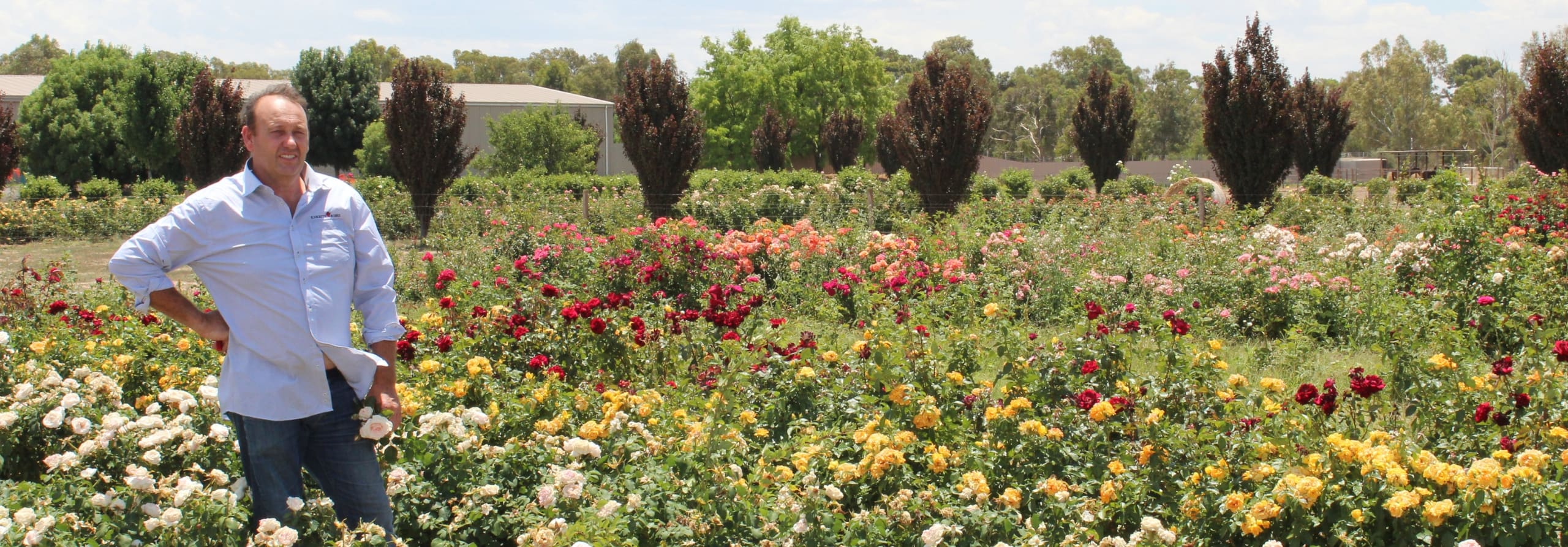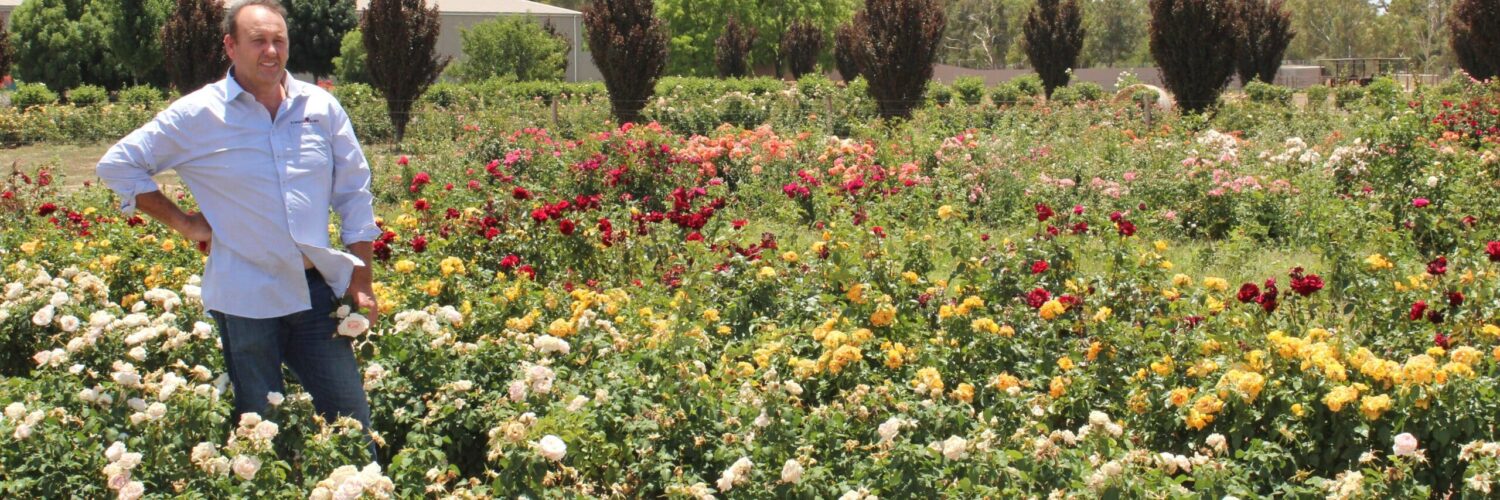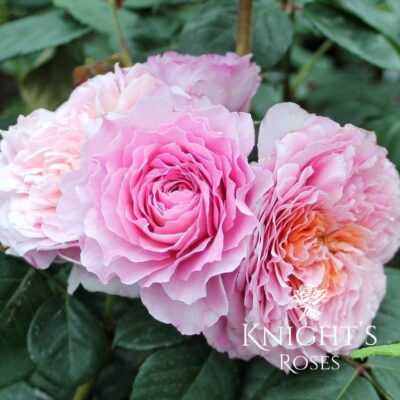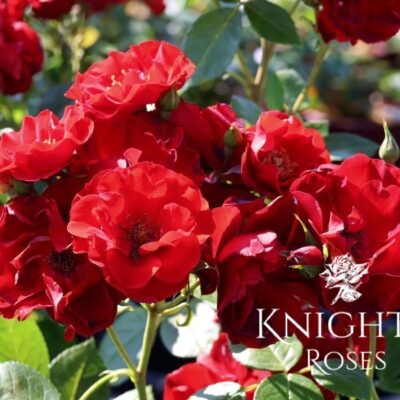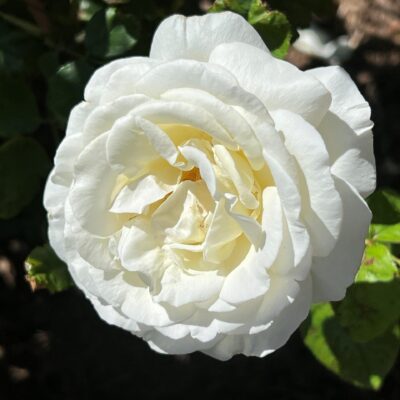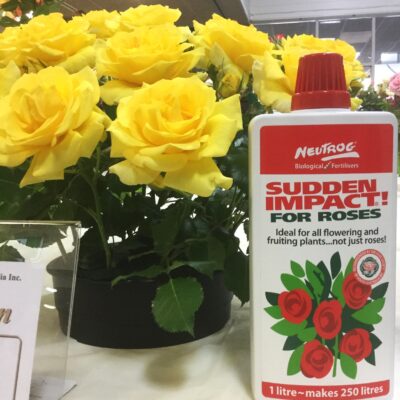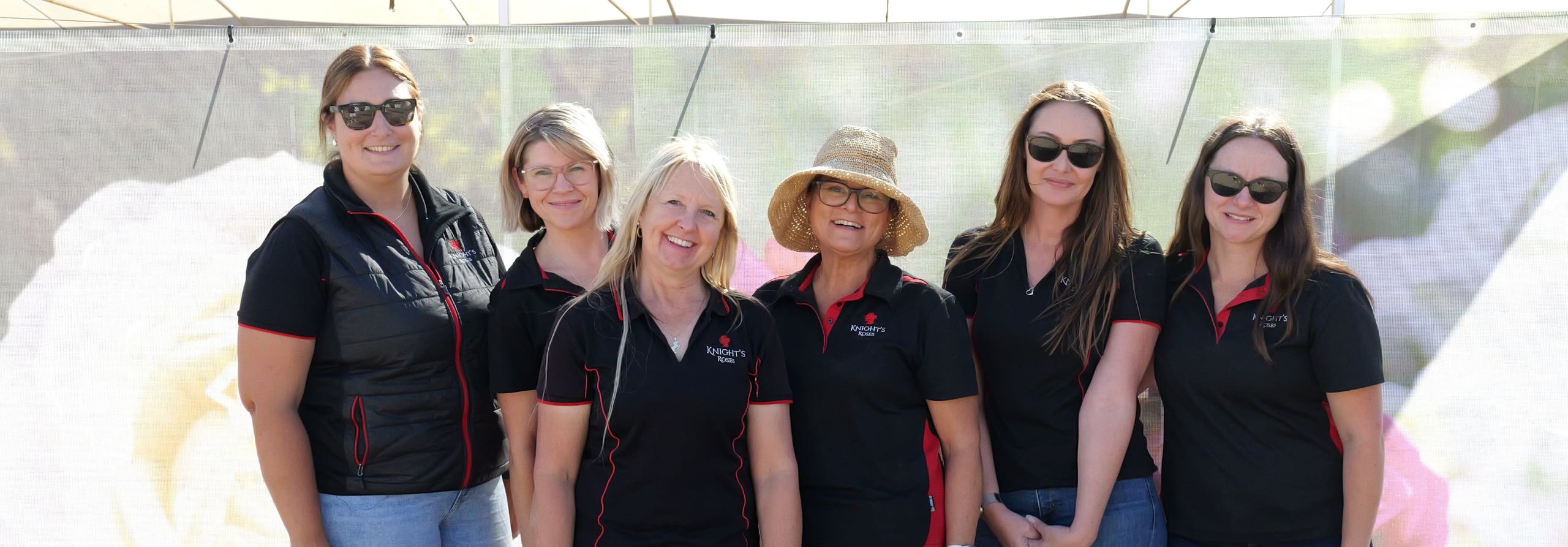
WINTER NEWSLETTER
June 2025
COME TO OUR WINTER OPEN DAY AND ROSE PRUNING DEMONSTRATIONS
Knight’s Roses, 44 Jack Cooper Drive, Gawler
Saturday, 14th June, 2025 from 10am-2pm
You are invited to our Winter Open Day on 14th June and this year we have added two free rose pruning demonstrations held in conjunction with the Rose Society of SA.
This is a well-timed opportunity for you to brush up on your rose pruning skills and learn from the experts who will be running demonstrations at 11.00am and 12.30pm. Rose pruning rejuvenates your rose plants, shapes the bush and increases flowering. Of course, our Open Day will provide the ideal opportunity to purchase bagged and potted roses and meet members from the Rose Society who will be in attendance to provide helpful rose growing advice. We hope to see you there!
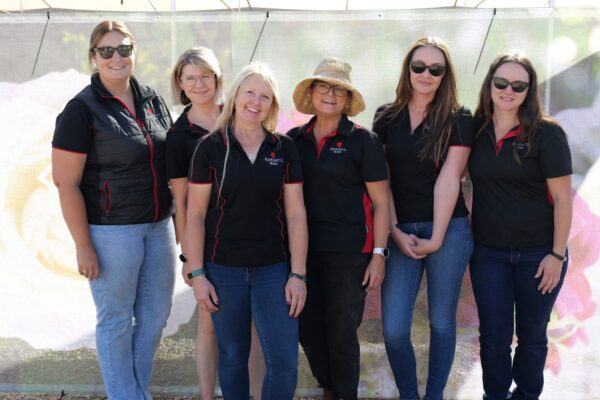
The Knight’s Roses Team
ORDER YOUR NEW SEASON’S ROSE NOW
View our extensive catalogue which includes many favourites and hundreds of varieties and order online or phone (08) 8523 1311. We are proud to present our new release roses for 2025 and our wonderful special cause roses which provide fundraising for well-known and worthy charities. This year we are celebrating 15 years since our Special Cause Roses were first introduced. Speaking of “special roses” read on to discover the special roses in Daniel Knight’s life.
ROSE GROWING TIPS FOR WINTER
We often associate the winter months with cold, wet conditions and a time when we can ignore the garden assuming “nothing much is happening”. However, for rose enthusiasts, this period can be busy with planting new roses, pruning existing roses and the removal of old foliage and generally cleaning up.
The average daily temperature in Adelaide in June is 16.1°C, in July 15.4°C and in August 16.6°C. These months are usually wet with an average rainfall of about 78mm in June, 75mm in July and 68mm in August.
Temperatures and rainfall vary significantly over the State during this period with it being colder and wetter in the Adelaide Hills, the South-East and Southern Yorke Peninsula and Eyre Peninsula. Frosts are also common in regional areas. Evaporation rates are very low and sunshine hours decrease.
So, what does this mean for our roses and how can we care for them during winter?
Watering
This is the only period in the year when rainfall usually exceeds evaporation. Therefore, there is no need to water our roses. The two exceptions which will require water are roses in pots and when planting bare-root roses.
Potted roses, particularly those undercover, need to be continually monitored and watered when they become dry. We suggest that you check them weekly.
Bare-root roses should be given at least a full bucket of water with Neutrog Liquid Seamungus added at planting time, this ensures new roots are damp and also removes air pockets in the hole.
Mulch
The easiest time to apply mulch is immediately after pruning when rose stems are bare and after the old fallen leaves and cuttings have been removed.
Generally, this will be late winter and before the roses begin to produce shoots. New shoots are very fragile and canbe accidently broken off.
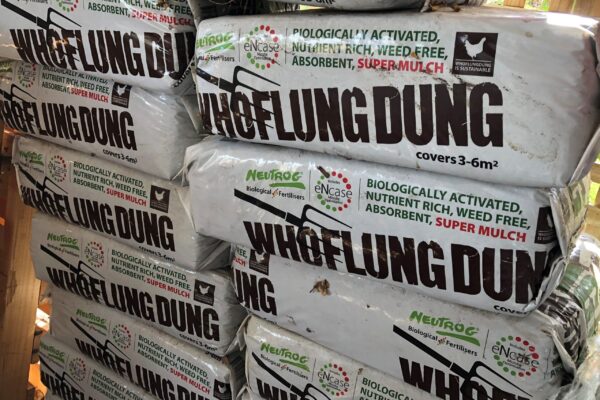
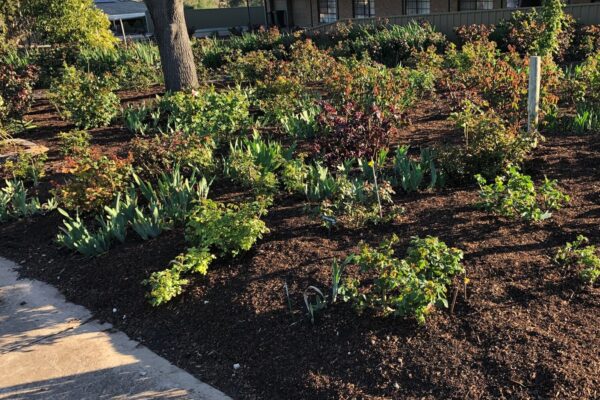
Neutrog’s ‘Whoflungdung’ has emerged as the “Mulch of Choice” for rose growers. An annual application of 5cm of mulch is recommended. While it can be applied immediately around the base of well-established roses (3 years and older) it is advised not to apply mulch closer than 15cms to new, one or two-year-old plants as occasional damage can occur to young basal shoots.
‘Whoflungdung’ comes in 20kg compressed bales. Apply water after application to settle the mulch in and reduce the initial odour which lasts a few days.
Mulch significantly reduces evaporation from the soil surface in spring, summer and autumn, saving up to 40% – 50% of the irrigation otherwise required; it cools the root zone and introduces beneficial bacteria and good microbial activity in the soil.
Fertilising
As roses are not actively growing in winter, they do not require feeding. However, immediately after pruning is completed and the ground has been cleaned up, roses benefit from an application of Neutrog ‘Seamungus’. This is a soil and plant conditioner, manufactured from seaweed, fish, humid acid and manure. It stimulates the roots into strong healthy growth in late winter and early spring. This assists the rose’s growth and ensures emergence from its winter dormancy is sustained by its root mass.
We recommend the use of pelletised Seamungus, as these pellets will breakdown with winter and spring rains over the next few months, enhancing root growth. It is also recommended that Seamungus is applied prior to mulching.
Pests and Diseases
As roses lose their leaves in winter, it is logical to assume that there is no need to control pests and diseases. In fact, the opposite is true. Once roses lose their leaves and assuming most of the fallen leaves are gathered up and disposed of together with any discarded rose prunings, winter is a great time for pest and disease control.
Fungal spores and pest eggs will be present on the bare rose stems, especially in cracks and crevasses. These will also be left on the ground under the plants. As such, they can readily be treated with winter dormancy sprays, for example oil sprays or Lime Sulphur. Copper Oxy Chloride sprays can also be used; however, these can be detrimental to earth worms.
Winter spray regime is the most important pest and disease control and will ensure significantly reduced problems in spring.
Planting New Roses or Transplanting a Rose
Planting is best done in June, July or early August. Allow ample space around each rose. Labels indicate indicative rose size. Choose an area which receives at least 5 to 6 hours of direct sunlight each day and is free of tree and shrub root competition. Full sun is recommended.
If it is a bare-root rose, remove the plant from its bag, shake off any sawdust and soak it in a full bucket of water for at least 6 hours or overnight. You can add either 20mls of Neutrog Liquid Seamungus or Neutrog GoGo Juice to the water, while the rose is soaking. If the new rose has been established in a pot, there is no need to shake the soil off prior to planting.
Dig a square hole at least 30cm square and deep. Place a small handful of Neutrog Seamungus pellets in the hole and cover with 2cm of soil. Trim or remove any broken or damaged roots with sharp secateurs. Broken roots can result in suckers (root stock) which can rapidly dominate. Position your rose in the hole so that the bud union (woody knob in stem where the branches emerge) is approximately 1 to 2 cm above the natural soil level. Observe where the roots fan out from the base of the plant. Remove the plant label from the plant as the label’s tie can quickly “strangle” a plant as it grows.
Remove the plant and create a mound (inverted cone of soil) in the hole such that when you place the rose back into the hole (at the correct depth) the base of the rose stem rests on top of the mound and its roots can be “fanned out” evenly from the shank of the plant. Back fill hole to approx. half full and fill the hole with a bucket of water. You can gently wriggle the rose to remove air pockets. Wait until the water drains away, backfill the hole to the natural soil level. The height at which the rose is planted is important. The bud union should be 1 to 2cm above ground level.
Winter rains should be sufficient to keep the plant damp until spring when supplementary watering may be required. It takes about 6 – 8 weeks for new roses to become established, therefore do not let the soil dry out completely.
Winter is the best time to transplant existing roses. This can be easily done until the rose is about 10 years old. To transplant a rose, use a sharp shovel or spade and dig all around the rose approx. 30cm out from the base to at least a spade’s depth (approx. 30cm).Remove rose and shake off all the soil. Reduce the top of the plant by at least 75%, leaving 3 or 4 canes about 60cm long. Remove any broken or damaged roots. Soak in a tub with Liquid Seamungus for at least 12 hours. Replant as per instructions above.
When planting a “standard”, “stem rose” or “weeping rose”, ensure the support (stake or hoop) is placed in the ground prior to planting. Locate the rose on the south-east side of the support which will provide shading to the stem from the hot sun. The rose should be tied to the support with recycled stocking or cloth ties. Do not use wire or non-flexible ties as these can choke the stem.
Rose Pruning
Start with climbing roses, followed by bush roses. Pruning is not a difficult task if you use the right equipment and follow a few simple rules. Pruning in July is recommended and avoid the temptation to prune too early.
Wear old clothes and all leather gloves – preferably gauntlets. A high-quality pair of bi-pass secateurs, like Felco or Fiskars is essential. You will also need good loppers and a pruning saw. A pruning saw is ideal for cuts over 2 ½ cm and removing old canes. Make sure your tools are sharp.

For a bush rose, don’t bother looking at the top third to half – this will be removed. Focus on the bottom half of the plant. Ideally, you want to retain strong, healthy, young canes and remove all dead wood, twiggy growth and weak branches. If sufficient new canes have grown from the base (water shoots), then you can remove old canes from the base. Also remove canes crossing over into the centre of the plant. Ultimately, you want the rose bush to resemble a vase shape. The outer rim canes should be reduced to one-third to half of their original height and cut to 3mm above an outwardly facing bud (eye). Remove all leaves.
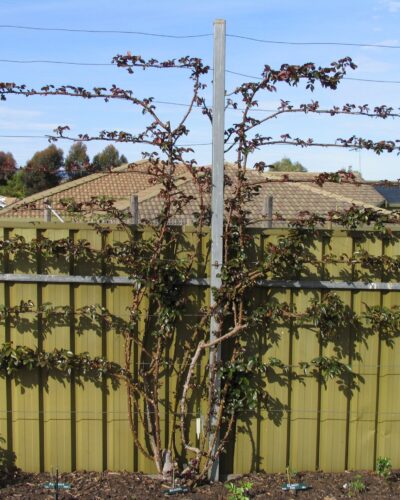
Climbing rose trained onto trellis
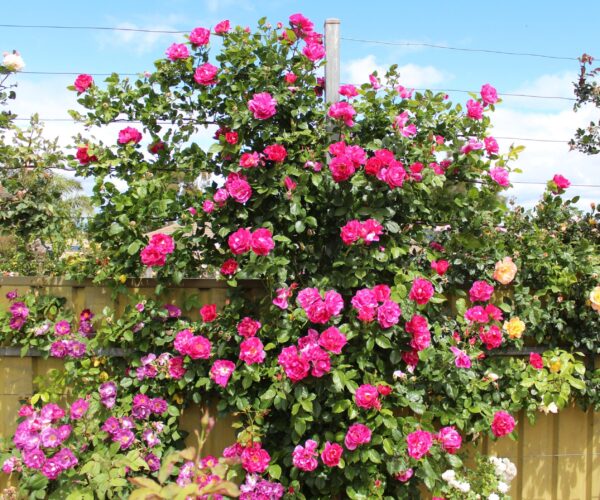
Guy Savoy – Climbing
For climbers, the plant almost “tells you what to do”. First, look at the base of the plant. If it has performed well in the growing season, there will be a number of new canes (these are still green with no side shoots) emanating from the base. These are called “water shoots” and will provide the best flowers in the spring. Therefore, do not remove these.
Secondly, move up from the base of the plant, following older canes (those which were left following the previous years’ pruning). Some of these will have strong new canes emerging partially along the old stem. Others will only have short stems all along the cane. These would have produced the flowers during the previous year.
Determine how many stems you require. As a guide most climbers need at least 12 canes in order to wrap 6 canes onto a trellis on each side of the plant.


Pruning and training Pillar Roses is easy. Ideally you need approximately 6 to 8 canes growing from the base to train them up. Every winter at pruning time remove as many older canes as possible and retain all the young, one year old canes (last season’s new growth). If you need to retain some older canes, spur prune the side shoots, like you would with a climbing rose. Ensure you have 2 to 4 canes to reach the top of the pole, the next 2 to 4 canes should be reduced to reach two-thirds up the pole and the last 2 to 4 canes to reach one third up the pole. This will ensure vertical colour the full length of the pole when therose comes into bloom.
Then simply wrap the canes around the pole, one at a time, half in a clockwise direction and the other half in an anticlockwise direction and then tie them securely at the top. A fine nylon rope which will not rot works best. The remaining canes can be wrapped around the pole and the ends fed under the already tied canes. This will hold them in place. Old foliage should be removed and fallen leaves and pruning remnants placed into green waste.
For beginners, contact the Rose Society and attend local Rose Pruning Demonstrations and see experts at work.
Other Winter Tips
Check your plant labels are still legible and in place. It is recommended that all roses be labelled and a map is kept showing where roses are planted.
LOOKING FOR THAT SPECIAL ROSE?
TRY OUR NEW RELEASES
Paprika
This rose produces clusters of blooms in vibrant brick red, creating an eye-catching display. It produces long-lasting, bright red, cupped-shaped flowers with a slight fragrance. A dense, bushy shrub rose, up to 1.3m tall, with repeat flowering over the entire season. Extremely resistant to fungal rose diseases.

Silver Flash
A beautiful top performing rose with great disease resistance. Luminous red blooms have amazing flashes of white on the petals. A bushy, well-shaped hybrid tea featuring fully double flowers enhanced by an intense fruity fragrance. It flowers all through the season and grows 1m tall.

The Sacrament Rose
Fragrant and beautiful, this Hybrid Tea rose is a tribute to the Sacraments of the Holy Church. It has large blooms of pure white with a creamy yellow centre. The classic flowers have a mass of petals per bloom enhanced by a strong citrus, peach and myrrh fragrance. Upright bush with good disease tolerance, growing to 1.2m.

“ROSES IN MY LIFE’ by DANIEL KNIGHT
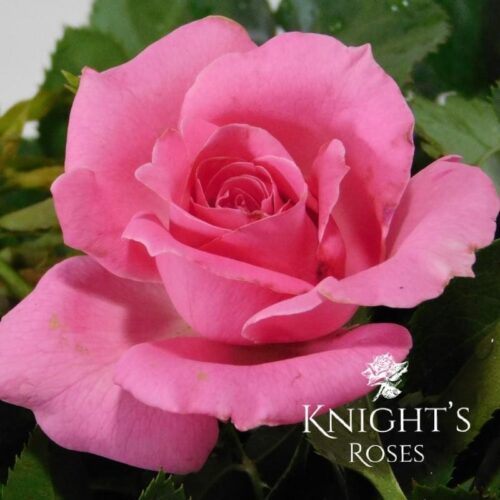
Pink Moon
‘Pink Moon’ was discovered at Knight’s Roses and surprisingly we have had quite a few different Hybrid Teas where mutations (sports) have arisen. As the name suggests, this rose is a pure pink ‘sport’ of ‘Blue Moon’, a famous Hybrid Tea introduced in 1965, bred by Tantau and known for its intensely fragrant lilac blooms and vigorous growth. I must add, ‘Blue Moon’ is still a very popular rose today.
‘Pink Moon’ was released in 2016. It has large, very fragrant, beautiful blooms on a vigorous, free flowering, healthy bush reaching approx. 1.2m. When I’m out in the rose fields and look down the rows, I can easily spot Pink Moon as it never fails to catch my attention and impress me with its bright colour and bountiful blooms. It’s always a “standout” from all the other roses surrounding it.

Amazing Mum
‘Amazing Mum’ was another fortunate “find” on our property. This Hybrid Tea rose is a sport of ‘Perfume Delight’ which came from the United States and introduced in Australia in 1977.
We have been growing it since it was released.
‘Amazing Mum’ has large, classic shaped, hot pink blooms with a strong damask rose fragrance on a vigorous upright bush. It was such a beautiful rose, I knew it had to be released with a very special name. The reaction from our customers has been fantastic.
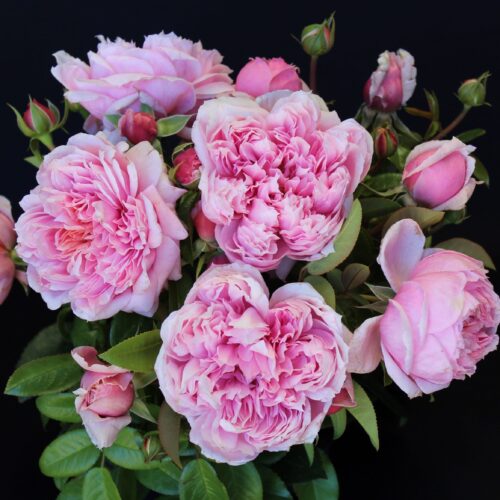
Per-Fyoom Perfume
This is one of my personal favourites. Years ago, there was a time when many of the newly released roses lacked perfume, often a trade-off when breeders were concentrating on a longer vase life and other characteristics. I’m pleased to say that while many roses have fragrance to some degree, some rose breeders such as Rosen Tantau are striving to produce varieties that are highly fragrant. Interestingly, roses are scented to attract bee pollinators.
Introduced in 2016, ‘Per-Fyoom Perfume’ is one of the most fragrant roses in our collection. This multi award winning rose produces clusters of cupped shaped blooms with a glorious Old World rose, myrrh and apple blossom scent. The bush is dense and bushy, growing 1.4m tall, with good resistance to disease. If you are looking for fragrance, I highly recommend this wonderful rose.
BECOME A MEMBER OF THE ROSE SOCIETY OF SA
Membership of the Rose Society of South Australia Inc. entitles you to:
- Four Bulletin magazines issued each year.
- The Australian Rose Annual – Produced by the National Rose Society approx. 160 pages of articles and rose information.
- Neutrog ‘Sudden Impact for Roses’ and other approved products may be purchased quarterly through the Neutrog on-line store at the Rose Society’s ‘members only’ special price.
- Participation in our Rose Shows
Regular meetings are held throughout the year and include where possible guest speakers, cultural Q&A and light refreshments. On occasions these meetings may take place in conjunction with a visit to a public or private garden and Rose Shows are held in April and October each year with a final Christmas luncheon in December. Information regarding meetings is published in the Bulletin and in the ‘meetings’ section of its website. If you have a rose you wish to be identified please bring it along, preferably with some foliage, to a meeting or rose show and our knowledgeable experts will make every effort to identify it for you.
Members and the General Public are most welcome to attend our Branch activities and meetings. Contact the Rose Society’s Branches in regional areas directly for information about their activities. Chaffey Rose Club is in the Riverland; the South-East Branch covers Naracoorte Penola and Mt. Gambier and Roses on Eyre is located on Eyre Peninsula.
Annual Rose Pruning Demonstrations are held in June and July and everybody is welcome to attend and learn from the experts.
For more information visit the Rose Society of SA website http://sarose.org.au
To contact Knight’s Roses – phone 08 85231311 or email retailsales@knightsroses.com.au or visit our website www.knightsroses.com.au

